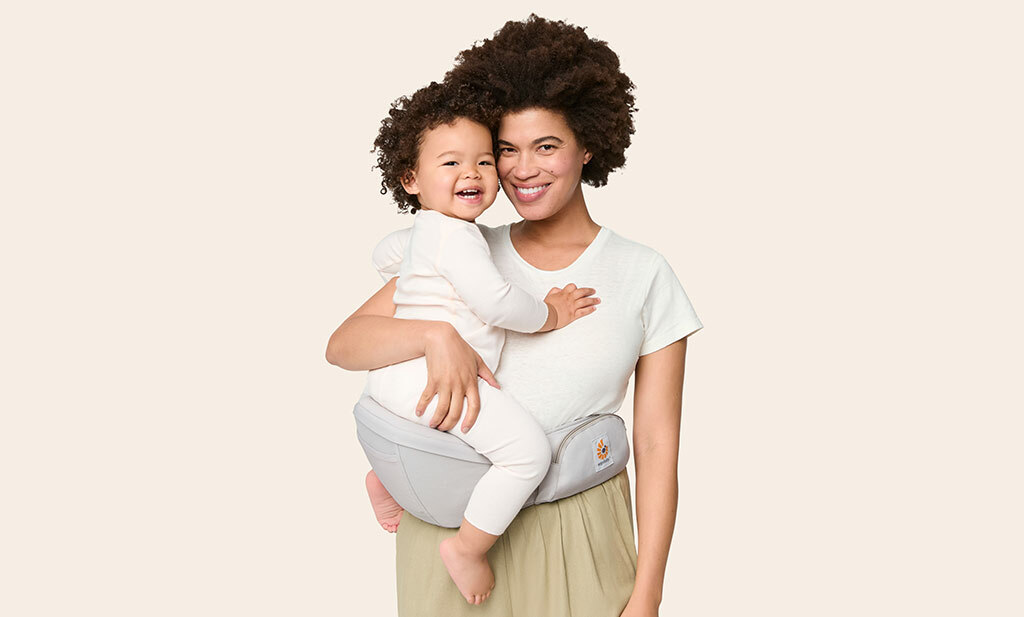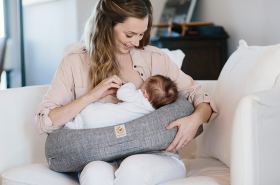
Up and down and up and down… If you have an older baby or a toddler, then this pattern will be familiar to you. Your little love wants to be held close but is still very active. One moment they want to be in your arms and then just seconds later the impulse to move or curiosity comes back and they want to be free to move on the floor. In moments like these, it’s usually not worth putting on your carrier because you will just be taking it back off again two seconds later. So instead, you push your pelvis to the side and carry baby on your hip.
The result: Suddenly your arms become heavy, you can feel your hips and lower back as they start to pull or even hurt. This repeated movement can cause a lot of things to go wrong in your body and it’s not good for your little one either. Today, with the help of our midwife and babywearing expert Katrin Ritter, we’ll tell you how you can carry your baby on your hips in an uncomplicated and ergonomic way by using a hip seat such as the Ergobaby Lift or the Ergobaby Alta.
Carrying your baby on your hip: what happens to your body without a carrier?
Carrying your baby on your hip. It’s quick, easy and so incredibly practical: your hip and arm support your baby or toddler and you still have one hand free to do what you were doing before your little one snuck up on you. Our babywearing expert Katrin knows this. But she also knows that this form of short-term or long-term carrying can lead to back pain and tension.
If you sit your baby on your hip, your whole body will become misaligned, as you can see in the photo above. Because you push your hips out to the side, your spine is crooked (deviates to the side) and with it your head, shoulders, shoulder blades and pelvis. This posture causes you to pull your shoulder blades forwards and all the muscles in your shoulders, arms, stomach and back are tensed in order to balance baby’s weight on your hips. This position also puts a lot of strain on the pelvic floor. Little one’s weight is distributed one-sidedly and not evenly across the body. In our test with a chiropractor we found that you have 2.5x the weight on your carrying foot when you hold your child on your hip versus when you hold them in the same position using a hip seat.
Possible consequences: Tension in the neck, shoulders and back, blockages in the spine and pelvis, headaches and possibly even wear and tear, chronic pain and osteoarthritis. Doesn’t sound so great, does it?
And unfortunately, if you carry baby on your hip without a baby carrier it not only disadvantages you, but also your child. Because although we are a carrying species, so our children have all kinds of anatomical features for being carried, unlike many other carrying species we don’t have any fur for them to hold on to. This means that squatting against your body without a baby carrier is hard work for your little one and often ends up in a less than ergonomic position. Your baby often doesn’t sit on your hip in the correct spread-squat position, but instead one or both legs hang down, they slips down, the upper body is crooked and your little one tries to keep their balance with tension in their whole body. Phew…..totally exhausting, isn’t it? Of course, you’re also trying to secure your baby well and pressing their private parts against you. Understandable, but it’s not comfortable or developmentally beneficial. This tight and tiring position can make you both work up a sweat.
Carrying your baby on your hip: What changes with a baby carrier?
Would you have thought it? That carrying your baby on your hip, which is so practical, could have such painful consequences? Don’t worry, we have good news. You can do something about it. The easiest way? A hip seat or other suitable baby carrier. Because, as you can see in the next photo, everything is back to normal again with the use of the Lift hip seat.
The spine is straight and so are the head, shoulders and pelvis. The muscles in the lower back, abdomen and pelvic floor are only slightly tensed and the arms are relaxed, as you really only have to hold your baby in position a little, not carry them. Their weight is evenly distributed over your body.
As you can see, the hip seat, with its wide hip belt and well-padded seat, lies really comfortably and firmly against your pelvis and takes all the weight off your little one. And it’s also much more comfortable, safe and ergonomic for them. This is because the Keep Baby Close™ angle and the non-slip surface of the seat on the Alta and Lift hip seat keep your child relaxed and where they belong without you having to press them against you. This also allows them to move much more freely and their legs are in the correct reclined/spread position. Another plus point, especially on warm days, is that you both sweat less in this tight position.
Cheers to hip carrying
From an evolutionary point of view, this is the original carrying position. Children are best able to squat (adopt an ergonomic position) here. This promotes the child’s overall development and motor skills: the child’s body tension and muscles are safely trained as well as their head control. The natural and ergonomic squat-spread posture on the hips is supported so that your child’s femoral head sits low and centred in the hip socket. In addition, the rotational movement in the spine is activated and your little one has a healthy foot position that allows them to support themselves perfectly against their parents’ body. It is therefore an all-round ergonomic carrying position. That’s why it’s not only possible with our new Alta and Lift hip seats, but also with our Omni, Adapt, Aerloom and Away carriers and our Aura baby wrap. By the way: the more often you change the carrying position (front, back, hip and front carry), the better it is for your child’s development.
Our additional tips for healthy babywearing
Whether on your hips, on your front or on your back – even if you always have a baby carrier at the ready, the time spent with a baby or toddler will always make itself felt physically at some point. That’s why we have a few tips for you that might even help you to get through the baby and toddler years completely back-pain-free.
- Always carry your little one with the support of ergonomic baby carriers. For longer carrying times and from birth use a carrier such as our Omni, Adapt, Aerloom, Embrace and for shorter carrying times an Alta or Lift hip seat.
- Always adjust the carrier correctly to suit you or the carrier and the child to ensure it’s ergonomic.
- Use the full range of carrying positions – always depending on your baby’s age and stage of development. This promotes your child’s development and motor skills the most.
- For all new mums out there: take it slow. After birth, leave most of the carrying to your partner if you have one and then slowly increase the amount. Your body needs rest, your core needs to stabilise and your muscles need to get back into shape.
- Specialist postnatal exercise to regenerate all structures is also a great idea and protects you from long-term consequences and pain. Daily exercise is not always easy to fit into such a busy everyday life with a baby. But just a few minutes a day can be enough. You won’t regret it. Of course, this also applies to other caregivers that will be carrying baby too.
Carry baby on your hip ergonomically, safely and comfortably
Our Ergobaby Alta and Ergobaby Lift hip carriers, as well as our other baby carriers, almost all of which allow hip carrying, clearly show that we absolutely recommend that you carry baby on your hip. Just with some help! Because your body will thank you in the end.



